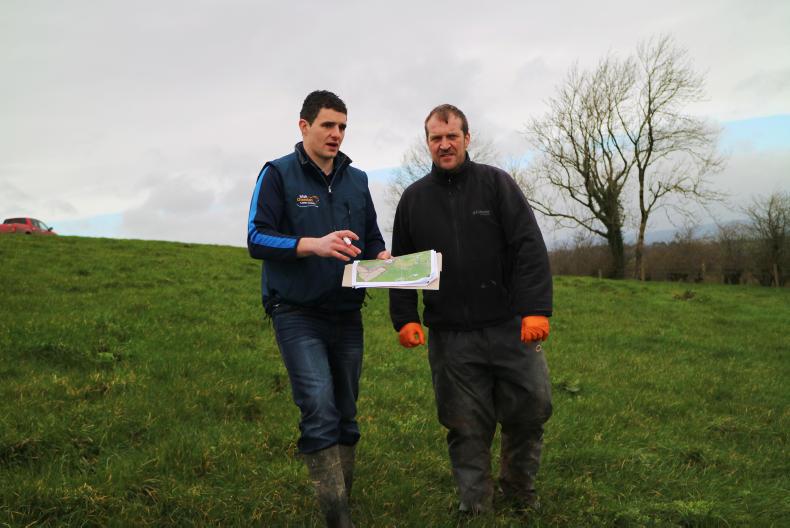Wesley Browne calved 78 suckler cows on 58ha in 2016. His farm is heavily fragmented – there are four different pockets of land within a 10-mile radius of his yard at Leagh.
Wesley’s typical suckler cow is a strong Simmental-cross, typically with a Limousin or Angus. The likes of Bawny T-Rex, Seaview Tommy and Milnafua Graduate (Simmentals) are well represented throughout his herd, having all had sons working it at some point. There are spatterings of the infamous Ronick Hawk (Limousin) in a lot of Wesley’s cows too.
With an average replacement index of €105 (five-star), Wesley’s herd is second only to Garreth McCormark – Cavan’s BETTER beef representative – in the programme’s replacement index league table.

For me, this figure needs further scrutiny when evaluating an animal or group of animals and looking within the overall index value, Wesley’s cows tick all the boxes. Milk averages +7.4kg (five-star) carcase weight (weight for age) is 19kg (five-star) and daughter calving interval is negative at -0.26 days (two star).
A small portion of Wesley’s herd calves early, in January and the balance calve in March, April and May. Bulls are finished out of the shed, under 16 months, and any non-replacement heifers are fattened for beef just before their second birthday.
As of last week, Wesley’s mature cows averaged 640kg. While his cows aren’t the heaviest in the programme, a mid-season ‘‘working’’ weight like this is substantial. Indeed, in a difficult spring given the heavy drumlin soil type on the farm, trying to get grass into them without damaging the land may seem like an exercise in futility. But, there is more than one way to skin a cat.
At the bottom of Wesley’s yard stands one of the finest multi-purpose cattle sheds that I have encountered. It has eight double bays – with both solid and slatted flooring, an excellent handling area and calving facilities. It is 3.6m high at the eaves and open-sided. The unit is fully fitted with 3G cameras.
Wesley also owns a zero grazer, enabling him get high volumes of grass into his animals’ diet and stretch his grazing seasons into the year’s shoulders. He does contract work with the machine on other farms in the area, when time allows, helping to spread the cost.
Farm output
As the ‘‘top trumps’’-style profile suggests, overheads (fixed costs) are high on this farm and this is expected given the investments in machinery and buildings. To justify these, Wesley must push farm output hard, and he is.
Wesley’s gross liveweight output in 2016 was 800kg/ha, compared with a national average of 477kg/ha. This came in to a monetary figure of €2,050 worth of sales per hectare and a gross margin just shy of €1,000. This should increase for a number of reasons in 2017, and beyond.
While under 16-month bull beef has been shown to be the most profitable system of suckler to beef production in Ireland, Wesley fed 1.5t of meal per cow across the whole herd last year. Though finishing a bull under 16 months with 1.5t of a total meal input is impressive, remember that only half of our calves are bulls.
With the help of BETTER farm adviser Tommy Cox and his local adviser Conal Murnaghan, he is upping his grass-game in an effort to reduce the reliance on meal – implementing paddock systems, being smart with his fertiliser and getting more grazing in the shoulders of the year – even if it means brining the grass to the cows. A trial with zero-grazed bull beef this year could further reduce his meal bill if it works out.
Wesley is also gradually increasing his suckler cow numbers, with an extra 20 to calve in 2018. Finally, the heightened beef price this year versus last year will obviously help his margins, but Wesley knows to concern himself primarily with what he can control when looking to drove profit.
Tables 1 and 2 break down Wesley’s bull-finishing performance in 2017. The 41 animals in question were born in spring 2016.
Overall, performance is very good (Table 1). Weight for age is exceptional, cattle are grading well (U=) and very few animals are going beyond weight or age specs. Carcase fat cover is potentially an issue for Wesley. He will need to look into his diets and feeding periods in 2018. In terms of stock bulls, his Simmental is producing heavier carcases at a younger age than his Limousin. Expectedly, his Angus is producing the lightest carcases, though many of these bulls would have been out of heifers and half were finished using zero-grazed grass (Table 2).


This year, Wesley decided to make more use of his zero grazer during the summer. A pen (12) of bulls were fed zero-grazed grass with varying rates of concentrates (€250/t). Cattle were started on 3kg of meals in mid-March and built up to 7kg for the final month pre-slaughter, along with grazed grass. While carcase weights were back compared with the meal-fed bulls, half of these bulls were Angus out of heifers.
Although Teagasc work has shown the difficulties around finishing suckler bulls on grass and meal, these trials were done outdoors. Housed animals have a 10% lower energy requirement relative to grazing animals, leaving more energy to go towards growth and fat deposition. The fact that his meal input was so low means that there is scope to squeeze it up slightly to improve fat score. It is hard to put a figure Wesley’s zero grazer given its value off-farm. However, with three weeks longer of a finishing period for 12kg less carcase weight and more animals out of spec, there is not likely to be much in it between concentrates and zero-grazing from a cost point of view. Consider the noise around the figures through – a more-balanced comparison in 2018 will be valuable.
